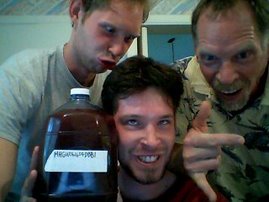
Hey guys,
Ok, so last night I got back on the horse and brewed a couple of beverages. Patrick and Tori came over about 7:00pm and we got to brewing basically the exact same stout you got a taste of. The only difference with this brew was that we left out the Acid malt since this adds a lot of sourness to the final product. We wanted this in the last stout because we were trying to clone Guiness, but since this will be a coffee stout, we left it out.
I have read that there are two camps when it comes to adding a coffee flavor to beer. Some brewers use heavily roasted grains which give the beer a toasted coffee flavor. These grains are steeped like tea at the beginning of the brewing process. I actually opted for the second method which is to simply add brewed coffee to the beer.
Then we had options as to when to add the coffee to the mix. You can add it in the initial fermentation, secondary fermentation, or drop it in literally as you go to bottle the whole mess. I will add it in at bottling time. Its the easiest way and you run a much smaller risk of losing the coffee flavors to high yeast activity.
So the stout is laid to rest for a few days. We finished that brew at about 10:30 so I thought I would whip up a test cider. I still had a one-gallon glass apple juice jug that mom gave me a few weeks ago. So I went to Tastybrew.com and looked up this recipe and scaled everything down for a one-gallon batch. This was pretty imperfect and required a good bit of judgement on my part. I added 1/2 teaspoon of ground cloves to the mix for spice. Unfortunately, I had to use baker's yeast because I keep forgetting to buy extra ale yeast packets when I'm at the homebrew shop. I'm not sure that this will be a problem as this brew is supposed to come in at about 4.9% ABV, and baker's yeast can hang out in up to 6%. Heres a quick run-down of my cider brew
Ingredients:
2 cans of frozen 100% apple juice
.5 cup of Sugar in the Raw (turbinado sugar)
1/2 tsp. ground cloves
1/4 tsp bakers yeast
Process:
- Combine frozen juice, sugar, cloves, and 1/2 gallon of water in pot and heat to 165 degrees farenheit for 5 minutes. (This is your wort)
- Remove from heat and cool to 80 degrees.
- Add cooled wort to primary fermenter and add cool spring water until the fermenter is full (NOTE: I left some space at the top of the jar so fermentation doesn't clog the neck.)
- Secure the airlock and place in a warm, dark place (NOTE: I wrapped a towel around the clear glass jug...fermentation hates light.)
I am expecting this fermentation to take much longer mainly because of the preservatives in the apple juice concentrate... I checked both brews this morning and the beer is rocking and rolling while the cider seems unchanged. The recipe that I based this brew off of says that the primary fermentation takes about 2 weeks and then he put it into secondary fermentation for another two weeks... So I'll probably report back on the state of the brew in about 2 weeks when I move it to secondary. I am hopeful.. I checked the original gravity (OG) and its right in line with the OG from the original recipe. If all goes well, the cider will turn out to be around 4.5 - 4.9% ABV
I will detail how I cobbled together the airlock for the cider in another post.
Below are some pictures of the cider once it was all laid to rest... I always forget to take in-progress pictures.







